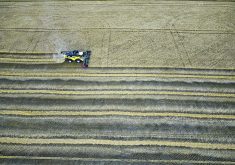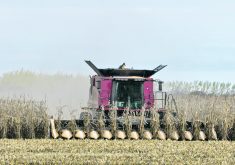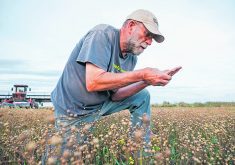Hot weather hurries harvest along Canola will heat in the bin, farmers reminded to begin cooling this crop as soon as it is off the field
Harry Brook stopped short of using the “B” word to describe Alberta’s crop but you could tell he was thinking it.
“I kind of hate to use the word bumper,” he said.
So instead he used the “A” word.
“They’re looking great. Those that aren’t hit by hail, the crops look awesome. We’ve definitely got a much better than average crop coming along,” said the Alberta Agriculture crop specialist.
Canola yields will be well over 40 bushels per acre, with many fields in the 50 to 60 range. Wheat crops should deliver 40 to 50 bu. per acre and barley will be in the 60 to 80 bu. range.
Read Also

Grain farming’s hard times expected to continue
Rabobank says it will be two more years before North American grain farmers achieve break-even due to “monster” supplies and “sticky” crop input prices.
“The thing that really strikes me I guess is that every crop almost everywhere looks good,” said Brook.
He was particularly struck by some of the fields he checked out near the Trans-Canada Highway.
“It’s hard to tell the irrigated crops from the non-irrigated crops. They look that good.”
In its July 24 crop report, Alberta Agriculture said 85 to 95 percent of the crops were in good to excellent condition.
“That’s unheard of,” said Brook.
Expected hot weather through August will likely hurry harvest along and have many Alberta farmers combining by mid-August.
Getting the crops off and in the bin, especially the canola, during hot weather is only half the battle, said Brook.
One farmer lost almost $40,000 worth of canola last year when 3,200 bushels that were harvested in the hot weather began to heat in the bin.
“A 50 bushel crop of canola that has heated in the bin isn’t going to be worth a hell of a lot.”
Brook reminded farmers combining in hot weather to begin cooling the canola as soon as its in the bin.
“It looks like harvest before the end of August. If that’s the case it’s got to cool down as quickly as possible or there will be grain beetle problems and crops going off.”
Grant McLean, crop management specialist with Saskatchewan Agriculture, said yields will likely be average to slightly above average in his province.
Heat stress is moderating expectations in many parts of the province.
Strong winds, heavy rains and hail are also taking their toll.
“Certainly some of these heavy crops have been going down,” he said.
Crops developed rapidly, causing some of the stems to be taller and not as rigid as they should be. That is wreaking havoc when combined with higher-than-usual storm activity.
The Canadian Crop Hail Association said there have been 7,600 hail claims in Saskatchewan as of the end of July, which is above the five-year average.
McLean said extensive lodging will slow harvest and may force producers to make different header choices.
Farmers are right on schedule in Saskatchewan.
Yields appear to be fairly typical in Manitoba.
“The best we can say is average right now,” said David Kaminski, manager of farm production extension with Manitoba Agriculture.
Winter wheat yields have been average to above average. Early-seeded spring crops also have decent yields but disease and insect damage are lowering the prospects for the later seeded stuff.
“Initial reports on quality are good,” said Kaminski.
He expected to see fusarium head blight in the winter wheat but it hasn’t materialized.
Harvest is ahead of schedule due to growing degree days or corn heat units being 10 to 15 percent above normal.
There has been too much moisture in the northwest of the province, while growers in the south are hoping for more rain to finish the crop.
Randy Dennis, the Canadian Grain Commission’s chief grain inspector, said they have noticed several lots of contaminated seed in both Eastern and Western Canada this harvest season.
Every year some treated seed left over from spring gets accidentally mixed in with the seed brought to the elevator, but this year, the number of contaminated canola, soybeans and wheat samples has been higher than normal.
“The frequency has been so dramatically increased. What is different this year? Who knows,” said Dennis of Winnipeg.
It is illegal for grain companies to accept treated seed and for farmers to deliver treated seed. This year samples have been detected at the grain terminals and grain companies have been ordered to hold back shipments until further testing is done.
“The highest number of contaminants has been in the canola,” said Dennis, who said the contaminated seed is readily identifiable by its colour.
Dennis said he doesn’t know if farmers are mixing leftover seed with the grain, or the grain handling equipment hasn’t been cleaned properly and the newly harvested grain is picking up the seed treatment.














